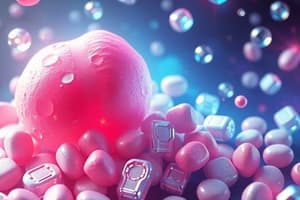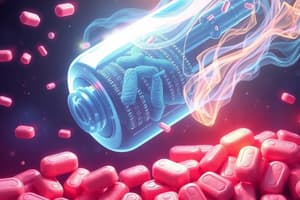Podcast
Questions and Answers
What is the primary precursor for all eicosanoids in the biosynthesis pathway?
What is the primary precursor for all eicosanoids in the biosynthesis pathway?
- Thromboxane
- Arachidonic acid (correct)
- Leukotriene A4
- Prostaglandin PGG2
Which of the following is NOT a function of eicosanoids?
Which of the following is NOT a function of eicosanoids?
- Modulating pain
- Reducing bronchoconstriction (correct)
- Inhibiting inflammation
- Regulating platelet aggregation
What effect do NSAIDs have on prostaglandin production?
What effect do NSAIDs have on prostaglandin production?
- They inhibit COX-1 and COX-2, reducing PGG2 production (correct)
- They increase the production of PGG2
- They enhance the activity of phospholipase A2
- They convert PGG2 to thromboxane
What result occurs when phospholipase A2 acts on cell membrane phospholipids?
What result occurs when phospholipase A2 acts on cell membrane phospholipids?
Which of the following statements about leukotrienes is true?
Which of the following statements about leukotrienes is true?
What is the primary role of an agonist in pharmacology?
What is the primary role of an agonist in pharmacology?
Which of the following best describes the concentration-effect relationship in pharmacodynamics?
Which of the following best describes the concentration-effect relationship in pharmacodynamics?
What are the two main processes described by pharmacokinetics (PK) and pharmacodynamics (PD)?
What are the two main processes described by pharmacokinetics (PK) and pharmacodynamics (PD)?
Which route of administration bypasses first-pass metabolism?
Which route of administration bypasses first-pass metabolism?
What is the significance of drug elimination in pharmacology?
What is the significance of drug elimination in pharmacology?
Why should children not be dosed as small adults?
Why should children not be dosed as small adults?
What stage follows drug discovery in the drug development process?
What stage follows drug discovery in the drug development process?
What is the advantage of generic medicines compared to brand-name drugs?
What is the advantage of generic medicines compared to brand-name drugs?
What is the primary effect of NSAIDs on COX enzymes?
What is the primary effect of NSAIDs on COX enzymes?
Which prostaglandin is important for heart protection and is made by COX-2?
Which prostaglandin is important for heart protection and is made by COX-2?
What is a potential side effect of acetanilide and phenacetin?
What is a potential side effect of acetanilide and phenacetin?
What is the predominant mechanism of action of paracetamol in the central nervous system?
What is the predominant mechanism of action of paracetamol in the central nervous system?
Why does paracetamol lack anti-inflammatory activity?
Why does paracetamol lack anti-inflammatory activity?
What is the resultant compound formed when paracetamol is metabolized?
What is the resultant compound formed when paracetamol is metabolized?
Why might children experience different effects when taking paracetamol?
Why might children experience different effects when taking paracetamol?
What do NSAIDs primarily prevent in the body?
What do NSAIDs primarily prevent in the body?
What is the primary role of proteins and nucleic acids in biochemical processes?
What is the primary role of proteins and nucleic acids in biochemical processes?
Which process is primarily influenced by the absorption of a drug?
Which process is primarily influenced by the absorption of a drug?
In drug development, which stage focuses on testing the efficacy and safety of a drug in humans?
In drug development, which stage focuses on testing the efficacy and safety of a drug in humans?
What characteristic of a drug is primarily affected by its stereochemistry?
What characteristic of a drug is primarily affected by its stereochemistry?
What is the main function of antagonists in pharmacodynamics?
What is the main function of antagonists in pharmacodynamics?
Which method of drug discovery focuses on the utilization of natural compounds?
Which method of drug discovery focuses on the utilization of natural compounds?
Which factor is least likely to influence drug response?
Which factor is least likely to influence drug response?
What is the primary purpose of drug regulation?
What is the primary purpose of drug regulation?
Which of the following best describes biotransformation?
Which of the following best describes biotransformation?
What aspect of pharmacokinetics primarily influences the duration of a drug's effect?
What aspect of pharmacokinetics primarily influences the duration of a drug's effect?
What effect does adding other lipophilic groups to the rings have on the structure?
What effect does adding other lipophilic groups to the rings have on the structure?
What does the suffix 'ac' or 'cin' imply about a compound?
What does the suffix 'ac' or 'cin' imply about a compound?
Which of the following is NOT a property shared among the NSAIDs analyzed by Novartis?
Which of the following is NOT a property shared among the NSAIDs analyzed by Novartis?
What is the partition coefficient of Diclofenac?
What is the partition coefficient of Diclofenac?
What does the introduction of an a-methyl group in carboxylic side chain result in for aryl propionic acids?
What does the introduction of an a-methyl group in carboxylic side chain result in for aryl propionic acids?
What is the primary challenge associated with drugs in the profen class?
What is the primary challenge associated with drugs in the profen class?
How does Diclofenac bind to proteins in the body?
How does Diclofenac bind to proteins in the body?
What was the primary aim of Novartis during the development of Diclofenac?
What was the primary aim of Novartis during the development of Diclofenac?
Flashcards are hidden until you start studying
Study Notes
Introduction to Non-Steroidal Anti-inflammatory Drugs (NSAIDs)
- NSAIDs are a class of drugs that reduce pain, fever, and inflammation.
- They work by inhibiting the production of prostaglandins, which are chemicals that cause pain, fever, and inflammation.
- NSAIDs are often used to treat conditions like arthritis, headaches, and menstrual cramps.
Analgesics
- Analgesics are drugs that relieve pain.
- They can be divided into two main categories: narcotic and non-narcotic.
- Narcotic analgesics, such as morphine, are derived from the opium poppy and are highly effective at relieving pain.
- Non-narcotic analgesics, such as NSAIDs, are not as potent as narcotics but are generally safer.
Eicosanoids
- Eicosanoids are a group of lipids that play a role in inflammation, pain, and other physiological processes.
- They are derived from arachidonic acid, a fatty acid found in cell membranes.
- Different types of eicosanoids, such as leukotrienes, thromboxanes, and prostaglandins, have different effects on the body.
Eicosanoids Biosynthesis
- Phospholipase A2 is an enzyme that converts phospholipids in cell membranes into arachidonic acid.
- Arachidonic acid is the precursor to all eicosanoids.
- Lipooxygenases (LOX) enzymes convert arachidonic acid into leukotrienes, which are involved in airway edema and bronchoconstriction (asthma).
- Cyclooxygenase (COX) enzymes convert arachidonic acid into prostaglandins, which modulate pain, inflammation, and fever.
NSAID Mechanism of Action
- NSAIDs inhibit COX-1 and COX-2 enzymes, which prevents the production of prostaglandins.
- This reduces inflammation and pain.
- However, inhibiting COX enzymes can also increase the production of leukotrienes, which can worsen asthma symptoms.
- Steroidal drugs inhibit the production of arachidonic acid, preventing the production of all eicosanoids, including leukotrienes.
Paracetamol (Acetaminophen)
- Paracetamol is an effective analgesic and antipyretic but lacks anti-inflammatory activity.
- It is a prodrug that is metabolised in the body to form AM404, which is an agonist at cannabinoid receptors.
- Paracetamol also inhibits COX-3, but only in the central nervous system, which explains its lack of anti-inflammatory effects.
Arylalkonoic Acids
- Arylalkonoic acids are a large group of NSAIDs that includes acetic and propionic acid derivatives.
- Acetic acid derivatives have two carbon atoms and include drugs like diclofenac and indomethacin.
- Propionic acid derivatives have three carbon atoms and include drugs like ketoprofen and ibuprofen.
Indomethacin Development
- Indomethacin was discovered in 1963 and is a potent anti-inflammatory and antipyretic.
- It is used for short-term treatment of acute gout, ankylosing spondylitis, and osteoarthritis.
Diclofenac Development
- Diclofenac was developed by Novartis and is a potent NSAID with good tolerability.
- Its structure is similar to other effective NSAIDs, including phenylbutazone, mefenamic acid, and indomethacin.
Ibuprofen Development
- Ibuprofen is a chiral molecule, with two enantiomers (R- and S-isomers).
- Most ibuprofen formulations are marketed as a racemate (mixture of R- and S-isomers) because the R-enantiomer quickly converts to the S-enantiomer in the body.
NSAID Binding
- Diclofenac binds to serine residues in the COX enzyme in a similar way to aspirin.
Studying That Suits You
Use AI to generate personalized quizzes and flashcards to suit your learning preferences.




